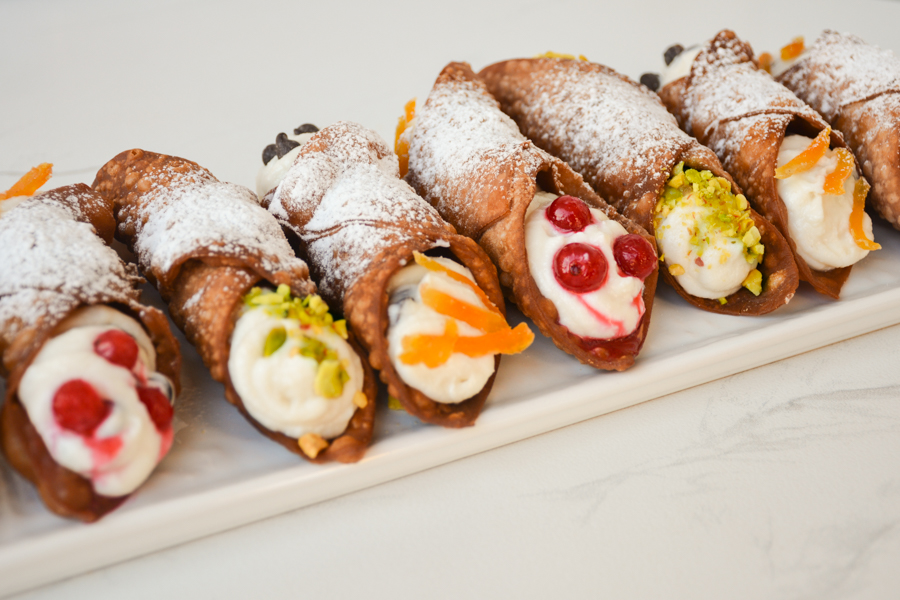Learn the secrets to make the Authentic Sicilian Cannoli Recipe, the traditional Italian cannoli filled with ricotta and chocolate chips. Fry the crispy pastry shells, then fill and decorate them for a delicious, authentic Italian dessert.
Have you ever tasted authentic Sicilian cannoli? If not, you’re in for a treat. My friend Carmela is from Palermo, and she’s agreed to share her family’s generational recipe for creamy ricotta filling and light, crispy pastry shells. In just a few simple steps, you’ll be whisked away to the cobblestone streets of Sicily without ever leaving your kitchen. Say Addio to premade shells and fillings from the grocery store, because after one bite of Carmela’s melt-in-your-mouth cannoli, you’ll never want to go back. Are you ready to indulge in a classic Sicilian experience? Then grab your apron and let’s get cooking!
What are Cannoli Siciliani
Cannoli Siciliani, also known as Sicilian cannoli, are fried pastry tubes filled with a sweet ricotta-based cream. They originate from Sicily, Italy and are one of the most famous Sicilian pastries. The word “cannolo” comes from “canna” meaning cane or reed, referring to the cane-shaped tubes.
Cannoli consist of fried pastry dough wrapped around metal tubes to create the familiar tube shape. Once cooled, the tubes are filled with a sweetened ricotta cream, often containing candied citrus peel and chocolate chips. They are usually dusted with powdered sugar and sometimes topped with cherries or pistachios. The fillings can vary, but ricotta-based creams are traditional.
To make authentic cannoli, use sheep’s milk ricotta, Marsala wine, and the highest quality ingredients. Frying the pastry tubes to a perfect golden brown and filling them just before serving ensures you’ll experience cannoli at their best – lightly crispy shells giving way to a creamy, not-too-sweet filling. No wonder, cannoli have become popular around the world!
The History and Tradition Behind Sicilian Cannoli
The cannoli originated in Sicily, Italy during the Arab conquest of the island in the 9th century. The Arabs brought sugar cane to Sicily, which allowed the locals to create the fried pastry tubes and fill them with sweetened ricotta.
Cannoli became popular in Sicily and spread throughout Italy. Traditionally, cannoli were eaten during Carnival, the festival held in Italy before Lent. Today, cannoli are enjoyed year-round but remain most popular around Easter and Christmas.
According to legend, nuns in Sicilian convents created the cannoli. They made the pastry tubes to resemble bamboo rods and fried them to keep the ricotta filling from spoiling during Lent, when Christians abstained from dairy and meat. Whether or not the legend is true, cannoli do originate from Sicilian nuns and helped popularize ricotta, a dairy product made from sheep’s milk whey.
Cannoli are meant to be enjoyed with family and friends. Their crispy, fried shells and sweet ricotta filling represent the warmth, generosity and hospitality of Sicilian culture. No matter where you are, cannoli can transport you to the cobblestone streets of Sicily and make you feel like part of an Italian family feast.
Watch The Video Recipe
Authentic Sicilian Cannoli Ingredients
INGREDIENTS
These are the ingredients you will need for this recipe. Please read the recipe card for the exact quantities.
For Cannoli:
- Sheep ricotta or cow ricotta
- Granulated sugar
- Dark chocolate chips
- 00 flour or all-purpose flour
- Unsweetened cocoa powder
- Strutto or butter
- 1 sachet vanilla or vanilla extract
- Sea salt
- Egg
- Cinnamon powder
- White wine vinegar
- Marsala wine or red wine
- Vegetable oil for frying
To decorate:
- chopped pistachios
- candied orange
- chocolate chips
- candied cherries
- fresh berries
- powdered sugar
Where You Can Find Metal Tubes for Sicilian Cannoli
What can you replace the metal tubes for Sicilian cannoli with?
Cannoli are classic Sicilian pastries that are traditionally made by wrapping dough around metal tubes and then frying them to achieve their iconic crisp, hollow shape. Here you can buy Cannoli Tube, however, if you don’t have cannoli tubes on hand, there are a few alternatives you can use:
- Aluminum Foil: You can shape strips of heavy-duty aluminum foil into cylinders. Make sure they are tightly packed and secure so they can hold the shape of the cannoli.
- Wooden Dowels: If you happen to have wooden dowels of the right size, they can also work. Make sure to wrap them in aluminum foil before using them to prevent the dough from sticking.
- Stainless Steel Cream Horn Molds: These are often used for making cream-filled pastry horns, but they can also work for cannoli. They’re similar in shape to cannoli tubes, just slightly conical instead of cylindrical.
- Bamboo Canes: take a bamboo cane of the desired thickness and cut it into 12-15 cm pieces. Leave them to dry in the sun for a few days or in the oven at 60°C for as long as necessary, and use them just like metal tubes (see this video).
Remember, regardless of what you use, the key is to ensure that your substitute can withstand the high heat of the frying process without damaging the cannoli shells or the cooking medium.
How to Make Italian Cannoli with Ricotta Cream
Can you believe you can make Sicilian Cannoli by hand, without expensive food processors? Here’s how it’s done:
Authentic Italian Cannoli Filling Recipe:
Drain the ricotta by squeezing it in a cloth. Transfer it to a bowl and mix with sugar until smooth using a blender. Add chocolate chips and mix well. Refrigerate the mixture for at least 4 to 5 hours.
Authentic Italian Cannoli Shell Recipe:
Sift cocoa and flour together. Use an electric whisk to combine strutto (or butter), vanilla, cinnamon, salt, and sugar until smooth and fluffy. Gradually add 1/2 beaten egg and continue mixing. Alternate adding the sifted flour and cocoa with wine vinegar and Marsala. Keep adding until you have a workable dough. Sprinkle with flour if needed. Cover the dough with plastic wrap and refrigerate for at least 1 hour.
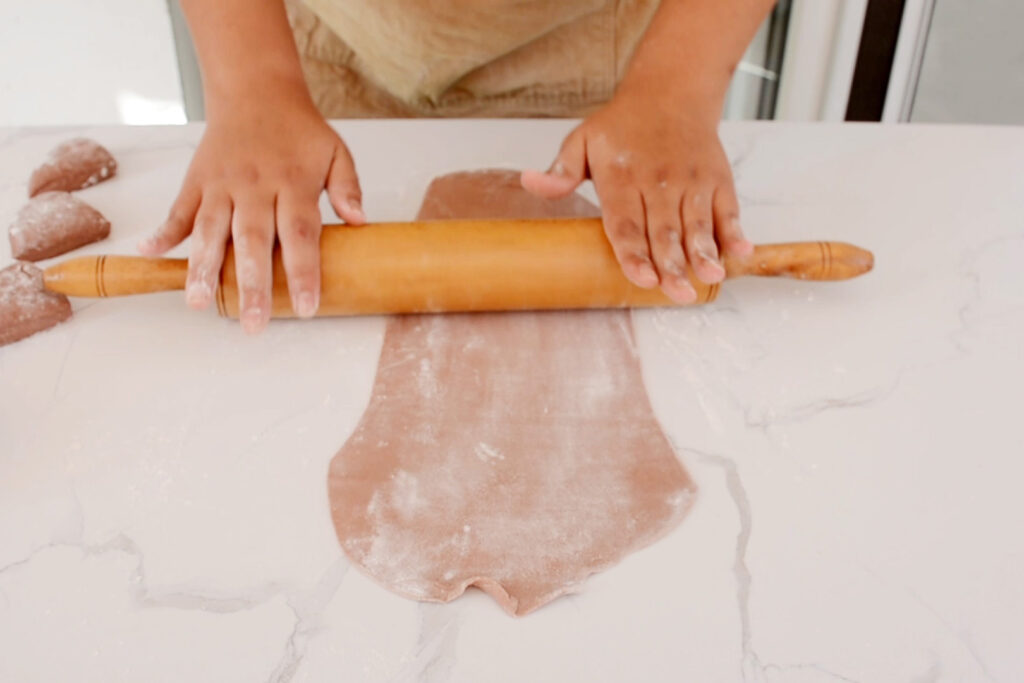
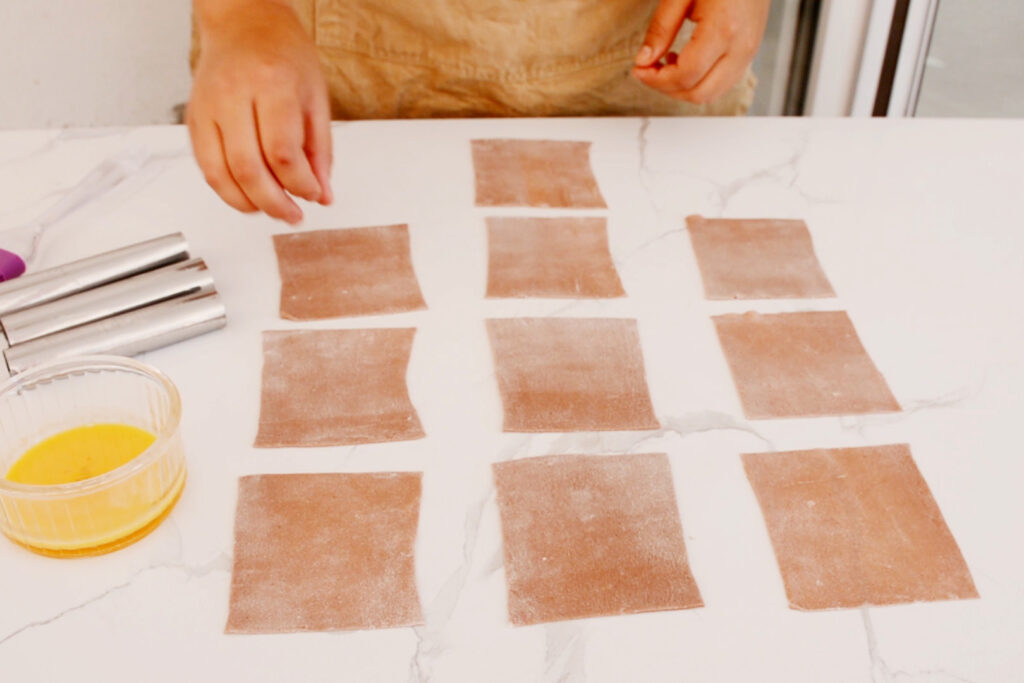
After the dough has rested, divide it into 3-4 parts. Roll it out thinly using a pasta machine or rolling pin until it is 2-3 mm thick. Fold the dough several times, adding flour between each fold, until you have a non-sticky sheet. Cut the sheet into squares about 10 x 10 cm. Make sure the square size matches the cannoli tubes to avoid difficulties in removing it after cooking. Adjust the size if using smaller cylinders. Place a cylinder in the center of each square, brush with beaten egg, and seal the cannoli by folding the other flap over the egg. Repeat for all the shells. Refrigerate the shells for at least 1 hour to ensure they hold their shape during frying.
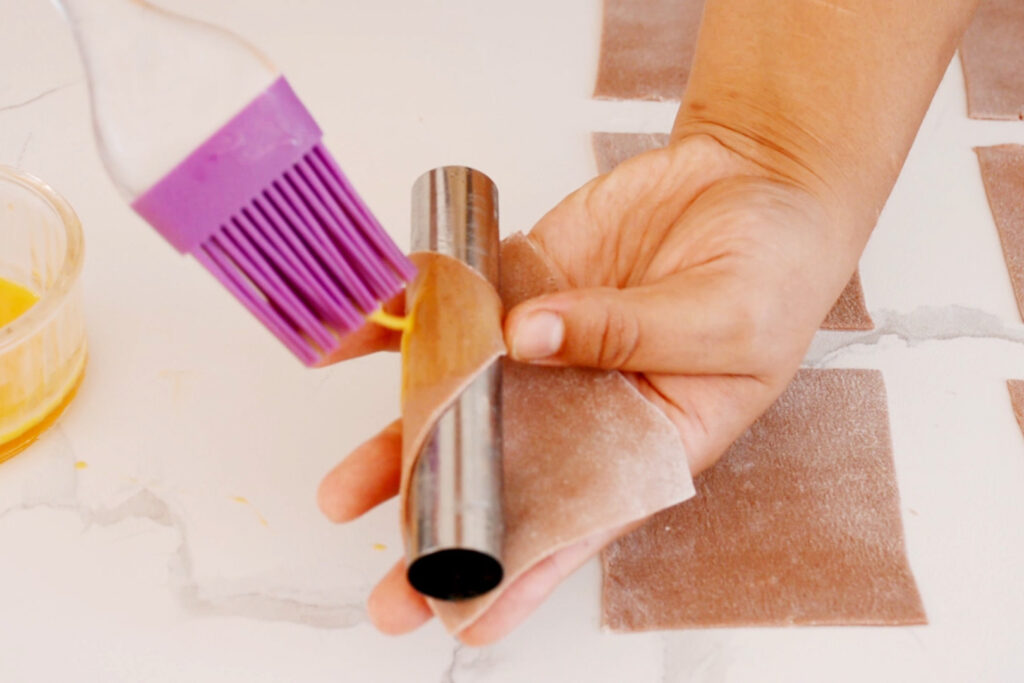
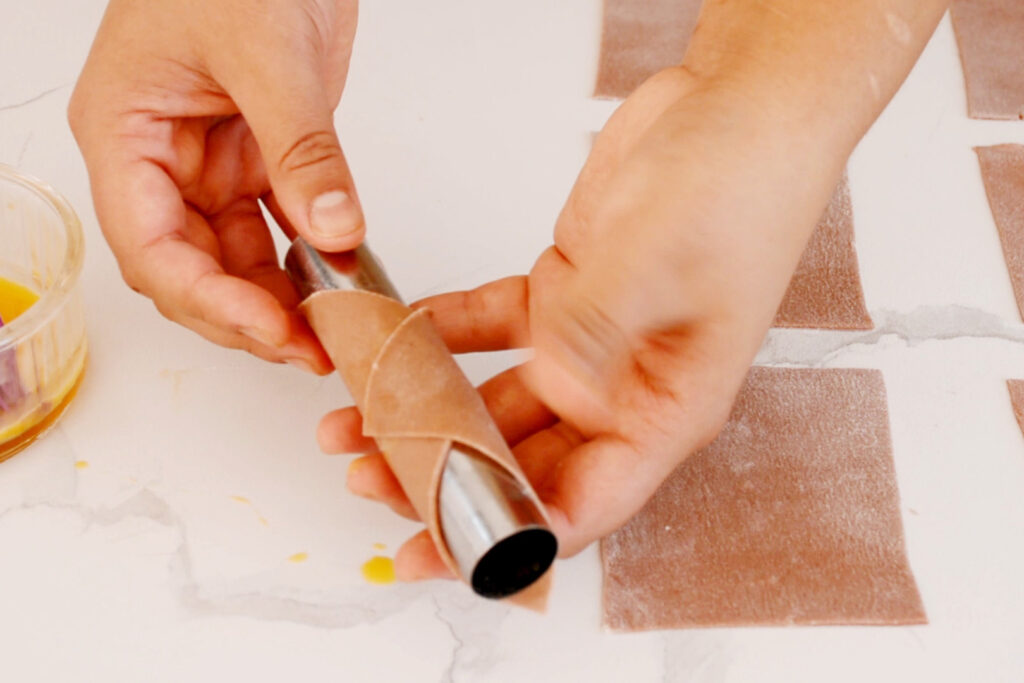
How to Fry Cannoli Shells Perfectly:
Heat frying oil in a small, deep saucepan. Use a cooking thermometer to monitor the temperature, which should be 175 °C (350 °F). If the oil is not hot enough, the cannoli shells will be greasy. If it’s too hot, they’ll burn before cooking through.
Fry one shell at a time, flipping it a couple of times for about 1 minute. It should rise to the surface and create bubbles. Drain the fried shells on paper towels and remove the cannula immediately to prevent sticking. Be extremely careful, as the oil will be dangerously hot! Repeat the process for the remaining shells.
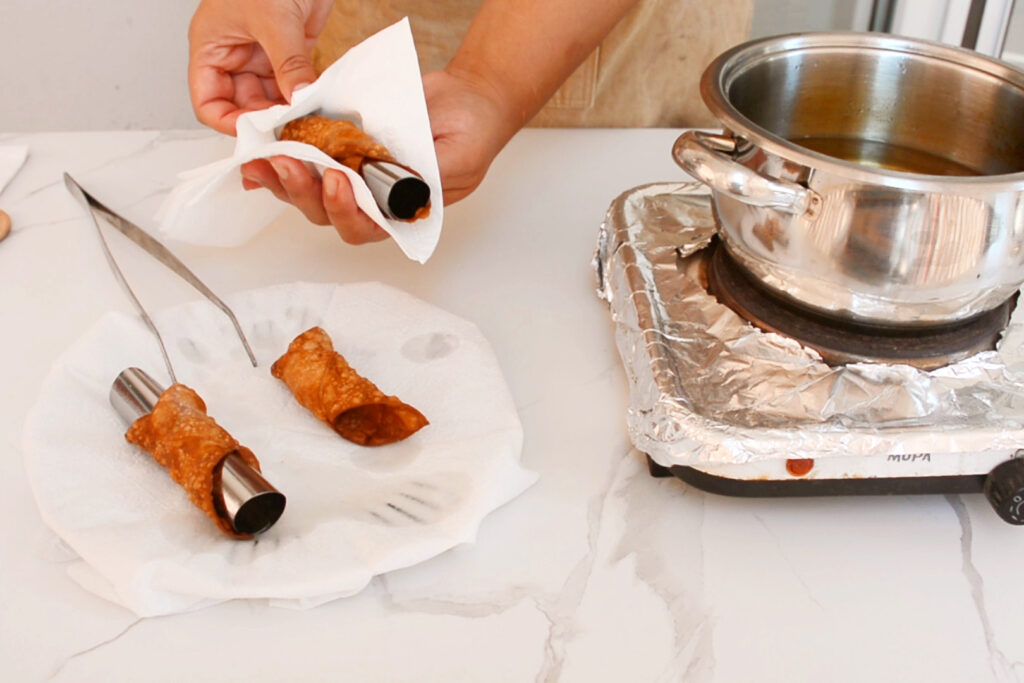
Allow the shells to cool before filling them with ricotta cream.
Filling the shells
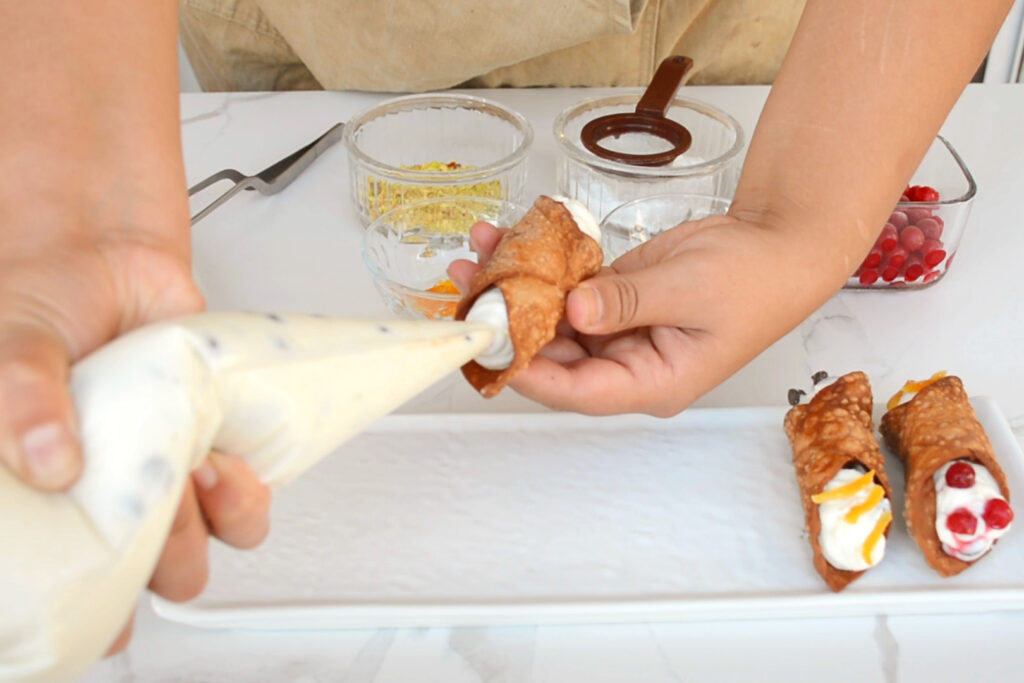
Once the shells are completely cooled, use a spoon or piping bag to fill the crispy shells with the sweet ricotta cream. Start by filling one side, then the other. Fill until the cream is evenly distributed and the ends are bulging slightly.
Decorating and Serving Your Homemade Sicilian Cannoli

Dipping in Chocolate (Optional)
If desired, you can dip the ends of the filled cannoli in melted chocolate for an extra special treat. Melt some semi-sweet chocolate chips and dip just the ends in, letting the excess drip off. Place on a wire rack so the chocolate can set.
Garnish (Optional)
You can also garnish your cannoli with candied cherries, chopped pistachios, candied citrus peel or mini chocolate chips for an attractive presentation and extra flavor. Arrange them artfully on top for a pop of color and crunch.

Dusting with Icing Sugar
Dust the filled cannoli generously with icing sugar. Use a sieve to lightly dust the entire surface of the pastry. The icing sugar will stick to the filling and any melted chocolate, giving the cannoli an authentic finish.
Enjoy!
Your homemade Sicilian cannoli are now ready to serve and enjoy! They are best served slightly chilled within 4 hours of filling. Buon appetito!
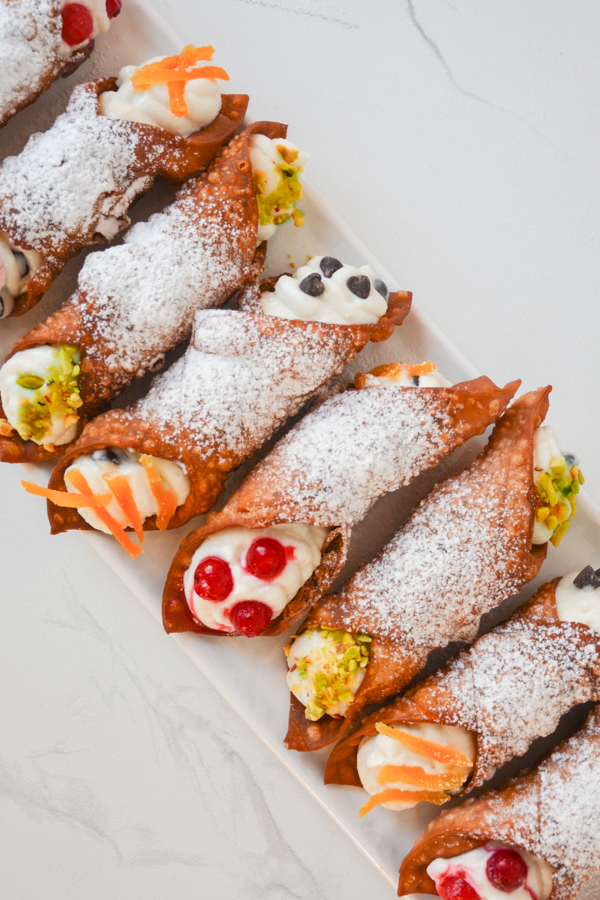
Main Problems in Preparing Sicilian Cannoli and How to Solve Them
The two biggest issues you may face when making cannoli are:
- Shells breaking or cracking. To prevent this, make sure to roll out the dough thinly and evenly. Let the shells cool completely after frying before filling them. Handle them gently.
- Filling leakage. To avoid a messy cannoli, chill the filling for at least 30 minutes before piping it into the shells. This will make it firm enough to hold its shape. Seal the ends of the cannoli with a bit of melted chocolate or icing to plug any holes.
By taking your time and following these tips, your cannoli will turn out perfectly crispy and delicious every time. No more broken shells or leaky filling! With practice, you’ll be churning out dozens of these Sicilian treats for friends and family in no time.
Sicilian Cannoli Storage Instructions
Keep the Sicilian Cannoli in the refrigerator for 1 day if they are already stuffed! My advice is to make the shells, leave them at room temperature and fill with the ricotta cream only when you decide to serve your cannoli! Once filled, the shells tend to soften after 1 day!
Conclusion
There you have it, the secret to preparing authentic Sicilian cannoli at home. With a little time and patience, you’ll be serving up a classic Italian dessert that will transport you and your guests straight to the cobblestone streets of Palermo. Once you master the art of frying up light and crispy cannoli shells, filling them with sweet ricotta and chocolate chips is a breeze. Before you know it, you’ll be dusting off your hands, standing back, and admiring a platter of picture-perfect cannoli. Go ahead, indulge – you deserve it! And don’t forget to pour yourself an espresso, sit back, close your eyes, and soak in the feeling of la dolce vita.

Unveiling the Secrets to Authentic Sicilian Cannoli Recipe
Ingredients
For Ricotta Filling:
- 800 g sheep ricotta or cow ricotta
- 300 g granulated sugar
- 120 g dark chocolate chips
For Shells:
- 250 g 00 flour or all-purpose flour + more for dusting
- 1 teaspoon unsweetened cocoa powder
- 30 g strutto or butter, softened
- 1 sachet vanilla or 1 tablespoon of vanilla extract
- 50 g granulated sugar
- 3 g sea salt
- 1 beaten egg use 1/2 for the dough and 1/2 for closing the cannoli
- 1 teaspoon cinnamon powder
- 1 tablespoon white wine vinegar
- about 60 g Marsala wine or red wine
- vegetable oil for frying
To decorate:
- chopped pistachios
- candied orange
- chocolate chips
- candied cherries
- fresh berries
- powdered sugar
Instructions
Ricotta cream
- Drain the ricotta to perfection, squeezing it in a cloth. Then, transfer the drained ricotta into a bowl and combine it with sugar. Use a blender to create a smooth and velvety mixture, ensuring there are no lumps.
- Add the chocolate chips and thoroughly mix them in. Place the mixture in the refrigerator for a minimum of 4 to 5 hours.
Shells
- Sift the flour and cocoa together.
- Use an electric whisker to combine strutto (or butter), sugar, vanilla, cinnamon, and salt until smooth and fluffy. Add 1/2 beaten egg and continue mixing to combine everything.
- Gradually add the sifted flour and cocoa, alternating with wine vinegar and Marsala, until all the ingredients are used up and you have a workable and compact dough. If needed, sprinkle with a pinch of flour.
- Cover with plastic wrap and let it rest in the refrigerator for at least 1 hour.
Sicilian Cannoli shape
- After the indicated time has passed, divide the dough into 3-4 parts. Roll it out very thinly to a thickness of 2-3 mm using a pasta machine (or by hand with a rolling pin). You will need to fold the dough onto itself several times, adding flour between each fold until you obtain a compact sheet that doesn’t stick anymore!
- Divide the sheet into squares of about 10 x 10 cm. Be careful that the square size should be as big as the aluminum cylinder; it shouldn’t protrude, otherwise, you will have difficulty removing it after cooking! If you are using smaller cylinders, naturally, you will make squares of 7-8 cm.
- Place the cylinder in the center of each square, brush with the remaining beaten egg, and seal the cannoli by folding the other flap over the egg. Make all the shells of your Sicilian cannoli in this way.
- Place in the refrigerator for at least 1 hour. This step in the fridge is crucial! The cylinders need to be cold to withstand the high frying temperature!
Cooking
- Heat the frying oil in a small deep saucepan. Fry one shell at a time. It should take about 1 minute, flipping it a couple of times. You will see it immediately rise to the surface and fill with bubbles.
- Drain on paper towels and remove the cannula immediately! If you wait too long, they will get stuck! Allow the ready shells to cool and cook the rest!
Assemble Sicilian Cannoli
- When the shells are ready and completely cooled, fill the cannoli with ricotta cream and chocolate chips. Fill one side first, then the other.
- Finish by adding crushed nuts, chocolate chips, candied orange peel, and candied cherries on top of the cream. Dust with powdered sugar and serve!

